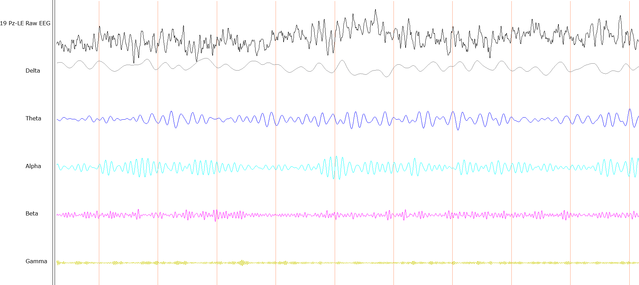Can EEG Headbands Measure Meditation?
Understanding the nuances and individual differences in brainwave data
The consumer-grade EEG headbands currently on the market allow people an opportunity to get a glimpse of how their brains work. Traditionally, EEG systems have been expensive and thus inaccessible to the general public. The affordability of EEG headbands means that nearly anyone can measure their brainwaves with an eye toward improving their meditation practice.
This access is wonderful! But what does all this EEG data really mean?
Turning the glimpse that the EEG headband offers into a picture of higher resolution requires an understanding of how to interpret the data these systems provide. There are many nuances and individual differences to consider when interpreting EEG data provided by any system, including the popular EEG headbands.
Below I will briefly cover a few of these:
Defining brainwaves
All devices provide information on the amount of specific brainwaves produced (amplitude). Usually, the EEG frequency bands are divided into delta, theta, alpha, beta, and gamma.
However, there is no uniform definition of these bands, and different researchers, clinicians, and companies define these ranges differently. For example, alpha is typically defined as 8-12 Hz. But sometimes, it is defined as 7.5-13.5 Hz. This is a considerably wider range of activity and is likely to produce higher values and less precision regarding specific states of consciousness.
Typical EEG bands. Source: Jeff Tarrant
Location, location, location
When trying to understand what certain brainwaves mean in relation to meditation, it is important to consider the location of the EEG sensors. For example, most neuromeditation research is concerned with the Default Mode Network (DMN), the hub of which is at the back of the head (Garrison, et al., 2013; Tarrant, 2020; van Lutterveld, 2016). Most EEG devices do not measure this area, placing active sensors on the forehead and temporal lobes (side of the head by the ears).
Brain Networks. Source: Dr. Riccardo Cassini and Dr. David Bercelli
Type of meditation
Different types of meditation have different impacts on the brain (see Tarrant, 2017; Travis, & Shear, 2010). As an example, Focus meditations activate the frontal lobes while deactivating the DMN. Mindfulness meditations activate the Salience Network while deactivating the DMN. Open Heart practices activate the left frontal area and Salience Network. Quiet Mind practices deactivate the DMN and language centers (left hemisphere).
To effectively measure most states of meditation, it is important to measure at least 2 different areas, oftentimes with opposing EEG patterns (Tarrant, 2017b). So, it becomes important to connect the locations monitored with the style of meditation. How are you using your attention and intention?
Activating vs. deactivating
In a lot of meditation research, clinicians are using brain imaging that measures blood flow. An increase in brain blood flow indicates activation; a decrease in blood flow indicates deactivation. However, with brainwaves, it is not quite that simple. Activation can be indicated by an increase of fast brainwaves (beta, high beta, gamma) OR a decrease of slow brainwaves (delta, theta, alpha), or some combination.
To make matters more complex, not everyone achieves activation or deactivation the same way. For example, someone with naturally low alpha may quiet their mind by decreasing high beta, while someone else may achieve that state by increasing Alpha1. In addition, many of the meditation headsets on the market do not make their algorithm known, making it impossible to know what specific state they are rewarding.
Let me present a scenario to show how all of this may come together.
Imagine you are using a headset that only measures the prefrontal lobes (on the forehead). You are doing a Focus meditation, which is designed to activate the frontal lobe areas. So far, so good.
Unfortunately, if the protocol is measuring activation, it will measure any activation, not just activation achieved by meditation. In other words, if you are ruminating on your to-do list or thinking about the weekend or planning for dinner, your mind is active. You are thus likely to get positive feedback even though your mind is actually wandering during the meditative practice.
What if the same device is measuring deactivation of the frontal lobes? When the mind becomes calm or quiet, it is likely that the slow activity will increase and the fast activity will decrease, and you will get positive feedback. So far, so good.
However, you could also receive positive feedback if you are falling asleep (which is not meditation) or dissociating (also not meditation).
These scenarios point toward complexity in interpreting EEG data. This complexity does not mean that consumer-grade devices are not useful. Rather, they are limited by what and how they measure meditative states for a particular individual. Recognizing these limitations is important so that the interpretation of results can be more accurate and meaningful.
At a minimum, the EEG meditation headbands effectively help increase awareness of internal states. For beginning meditators, this awareness can be a powerful motivator, helping to clarify their meditation practice and allowing them to track brainwave changes over time. At their best, consumer-grade EEG devices reinforce learning and practice in conjunction with meditation coaching or formal meditation training.
References
Tarrant, J. (2017a). Meditation interventions to rewire the brain: Integrating neuroscience strategies for ADHD, anxiety, depression, & PTSD. Eau Claire, WI, PESI Publishing.


